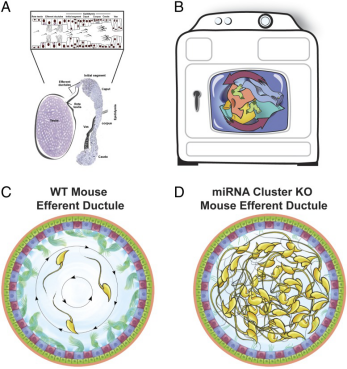睾丸里产生的精子不具备运动功能,它们如何通过狭窄的输出小管到达附睾?一直以来,人们认为输出小管上皮的纤毛摆动是精子通过输出小管的主要动力。然而近日,由美国内华达大学医学院闫威教授课题组、美国伊利诺斯大学HeSS教授以及上海交通大学医学院上海市生殖医学重点实验室徐晨教授、伍静文副教授课题组利用基因敲除小鼠(miR-34b,c-/-; miR-449-/-; Foxj1-cre-miR-34b,c-/-; miR-449-/-),结合形态学观察和动物手术解压等实验方法的合作研究中发现:输出小管上皮纤毛细胞的纤毛并不是全部朝着一个方向(朝着附睾的方向)呈波浪状摆动,而是朝着不同的方向呈鞭打式摆动,这样的运动方式对管腔中的液体产生一种向心力而形成液体湍流,使其中不具备运动功能的精子保持悬浮状态而不会阻塞管腔;运输精子到达附睾的动力主要来自输出小管管壁平滑肌收缩产生的蠕动。如果破坏输出小管纤毛细胞的结构和功能(miR-34b,c-/-, miR-449-/-; Foxj1-cre-miR-34b,c-/-; miR-449-/-小鼠输出小管的表型),将会造成精子阻塞管腔,这将导致管腔液体吸收障碍,过多的液体产生的反压力将导致睾丸生精上皮的萎缩从而导致不育;有趣的是,如果解除过多液体所致的睾丸的高压力,萎缩的生精上皮将得到恢复。这提示临床上某些少弱精症患者甚至无精症患者,其可能的首发病因也许不是睾丸生精障碍,而是输出小管阻塞所致;解除输出小管阻塞所致的原因也许可为这类疾病的治疗带来新思路。
这篇研究论文使人们对动纤毛的运动方式有了新的认识。动纤毛分布在机体中的呼吸道上皮、脑室或脊髓中的室管膜上皮、输卵管上皮以及输出小管上皮。多年来,人们认为机体中的所有动纤毛均是朝着一个方向呈波浪状摆动。然而这篇研究论文的发现使人们认识到动纤毛的不同运动方式。值得一提的是,此研究论文仅利用基因敲除小鼠,结合基础的形态学研究方法、灵巧的动物手术,“勘误”了人们长期以来默认为的“事实”。这提示我们,机体里还存在许多奥妙等待我们去发现。
该论文题目为: Motile cilia of the male reproductive system require miR-34/miR-449 for development and function to generate luminal turbulence。发表于Proc Natl Acad Sci U S A,
2019 Feb 26;116(9):3584-3593原文链接:https://pubmed.ncbi.nlm.nih.gov/30659149/
PNAS杂志针对该论文,发表了同期评述:“Male reproductive tract cilia beat to a different drummer”,文中阐述:该论文首次观察到小鼠输出小管中的运动纤毛呈现“涡轮搅动”式的摆动模式,这完全刷新了以前人们对纤毛摆动的认识,这种独特的纤毛摆动模式跟其它器官(大脑、呼吸道和输卵管)中纤毛摆动模式完全不同。原文链接:https://pubmed.ncbi.nlm.nih.gov/30692268/

Male reproductive system and rotational movement by motile cilia in the efferent ductules. (A, Lower). Male reproductive system showing the testes, rete testis, efferent ductules, and epididymis. Inset (Upper) depicts the epithelial surface lining these structures. Motile cilia are solely present within the efferent ductules. Adapted from ref. 20 by permission of Oxford University Press. (B) Similar to washing machine blades, the motile cilia move in a coordinated and rotational manner to agitate spermatozoa and surrounding fluid. (C) In WT mice, motile cilia swing back and forth to maintain spermatozoa in suspension and prevent agglutination. This rotational ciliary movement might also facilitate reabsorption of luminal fluid. (D) Mice deficient in two miRNA clusters have ductule ciliary dysgenesis (11). Sperm aggregation, luminal obstruction, and sperm granulomas result and lead to a fluid back pressure within the testes and eventual testis degeneration and infertility.(Proc Natl Acad Sci U S A. 2019 Feb 26; 116(9): 3361–3363)



